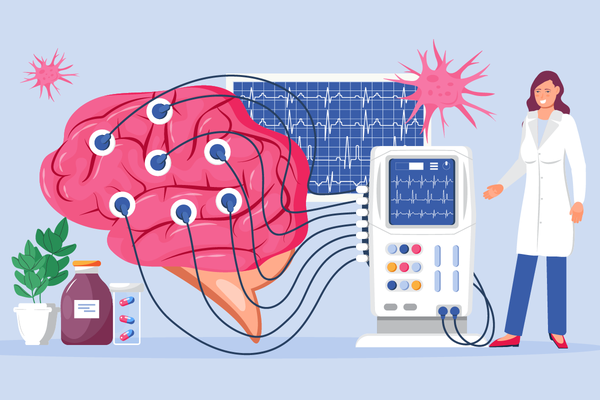As told to Nicole Audrey Spector
When I was diagnosed with multiple sclerosis (MS) almost seven years ago, the world nearly stopped for me. For a moment, I envisioned all the worst-case scenarios that MS could bring. I thought of not dancing at my daughters’ weddings. Of never traveling with my husband again. Of the most recent hike I’d taken. Would it be my last one ever?
I’m not one to dwell, so I didn’t stay frozen in this place of fear and self-pity for long. I whipped into action and, thanks to a great medical team (and no shortage of good luck and privilege), I was given the opportunity to opt for an aggressive treatment plan.
There is no cure for MS, but this treatment plan was as close as it gets.
Going aggressive wasn’t a snap judgment decision. The drug that would virtually stop MS in its tracks came with a few scary warnings. For one, it was advised that I not become pregnant because the medication could cause complications during pregnancy, including birth defects. This was somewhat upsetting, as my husband and I didn’t know how long I would be on the medication, and although we already had two children, we weren’t sure if we wanted more. Secondly, and even more terrifyingly, the medication could cause progressive multifocal leukoencephalopathy (PML), a rare and deadly brain disorder triggered by the John Cunningham (JC) virus, a common virus that can be dangerous for people with a weak immune system.
I looked my doctor dead in the eye and said, “If your wife were going through this, what would you tell her to do?”
I knew I had him pinned.
“I would advise her to start this drug and to start it now,” he said.
His input, along with the supportive words of a good friend and former colleague who reminded me that I’ve never been anything less than aggressive in life, inspired me to go for the aggressive, most effective treatment.
But being on an aggressive treatment doesn’t mean just sitting back and letting the drugs just do their thing. And just because I don’t feel like a sick person (in fact, at 42 I’m healthier and feel better than I felt at 22), it doesn’t mean I don’t have a disease that, if untreated, could flare and disable me. I must stay physically fit and take excellent care of myself. I must also speak up for myself and take measures to make myself more comfortable and safe, if able.
To help lessen the risk for PML while taking this high-risk drug, I was screened for the JC virus before my drug infusion therapy every time. This wasn’t something the doctors recommended but it was something I insisted upon, and getting the all clear helped increase my comfort level greatly.

These days, I’m on a different but still aggressive drug to treat MS and prevent it from getting worse. When I go in for my twice-yearly infusions, I like to use my time to do research on new therapies and new MS studies. I also use this time to talk with the nurses and hear about what other MS drugs are in the works or being rolled out to patients. When living with MS, it’s important to keep your ear to the ground on what’s happening, because medical advancements happen frequently.
It’s also important to keep an eye on your doctors and make sure they’re staying active and up to date on research and technology, as my doctors do.
I’ve been working together with the same doctors for years now. I deeply respect them and know that they respect me, too. I can feel it in my gut, and that’s crucial. I recommend that anyone who is living with MS — or any disease, for that matter — share a strong mutual respect with their healthcare providers. You really have to feel this respect deep in your bones. You’ll know if it’s not there.
I also highly recommend getting second opinions. Your health information is yours. Share it! And if and when you feel comfortable, talk about your diagnosis with friends, family and colleagues. It could help widen your medical network and get you access to more help.
It took me a while to open up publicly because I was a CEO raising capital to launch my business, Motherly, around the time of my diagnosis. In a time where only 2% of investment dollars went to women, I didn’t want to have to carry yet another stigma (I was already a mother, after all).
MS doesn’t end with a diagnosis. Even though I don’t feel sick and I don’t let MS define me, I do have an incurable disease, and I rely on medicine and healthcare providers to keep me well. The best thing I can do for myself is be my own loudest supporter and my best advocate throughout my journey.
This resource was created with support from Viatris.
- How I Live a Life Of Hope With Multiple Sclerosis ›
- Multiple Sclerosis Treatment & Shared Decision-Making - HealthyWomen ›
- How is multiple sclerosis diagnosed? - HealthyWomen ›
- Is it safe for me to get pregnant if I have multiple sclerosis? - HealthyWomen ›
- Finding Silver Linings Through My Work as a Health Advocate Has Helped Me Live with MS for 38 Years - HealthyWomen ›
- Questions to Ask Your Neurologist If You Have MS - HealthyWomen ›
- Facts About Joining a Registry - HealthyWomen ›
- Family Planning with Multiple Sclerosis (MS) - HealthyWomen ›







